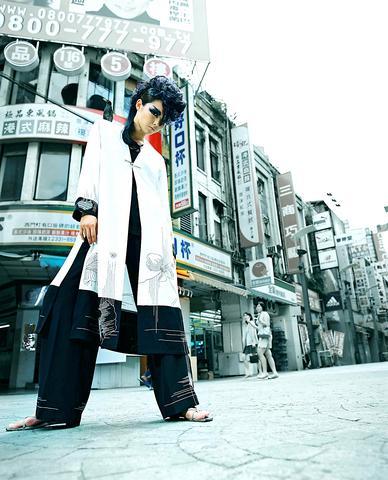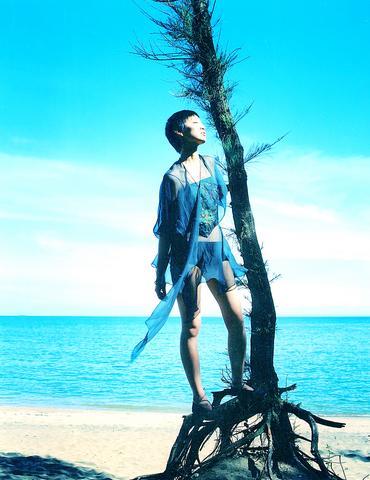It's the run-up to Fuse 2004, the event sponsored by the Ministry of Economic Affair's Industry Development Bureau (IDB), which is intended to put Taiwan' s fashion professionals on the world catwalk. Pity, then, that the show is already tripping over its hemline.
Conceptualized by international consultant, David Lim (林進南), Fuse was originally meant to present a month-long program of activities, including fashion shows, designer workshops and photo exhibits -- enough to entice designers and fashion industry heads around the world to Taipei. The IDB even planned to fork out money to fly the media into town on press junkets from US and European and fashion capitals.
In Lim's own words, Fuse was to be a "showcase of fashion concepts and innovation, sharing ideas, experiences and inspiration through collaboration with other creative talents, thus linking Taiwan fashion design talents globally."

PHOTO COURTESY OF FUSE
Instead, the month of activities has been pared down to little more than a week and to just a couple locations: a catwalk show on Aug. 16 at Stage, and a fashion photo exhibit at Eslite Bookstore's Dunhua South Road location that will run Aug. 14 through Aug. 22. No international press junkets. Hardly the showcase the industry had hoped for.
An indication of where the sponsors and organizers perhaps went wrong in promoting their event can be found on its Web site, www.fuse2004.com.tw, which does more to promote Lim and the event's partners than it does the designers.
The pecking order of things to read on the site begins, appropriately enough, with an "about the sponsors" section wherein the IDB outlines its mission for Fuse 2004. Next is Lim's resume, followed by a profile of Fuse's principal partner, rock star Chang Cheng-yue (

PHOTO COURTESY OF FUSE
We learn that A-Yue's favorite food is pizza and that he hopes to one day make a movie. If you're wondering what any of it has to do with promoting Taiwan's many fashion talents, you're not alone.
Only at the bottom of the site can you find information about the people for which Fuse has been founded. The 11 designers being promoted are Lee Chun-chih (李春枝), Jane Hu (胡雅娟), Hsu Chiu-yi (徐秋宜), Carole Chang (張 伊萍), Hsu Jen-yu (許仁宇), Hsu Yan-lin (許艷玲), Elise Huang (黃琇雯) Isabelle Wen (溫慶珠), Charin Yeh (葉珈伶), Chao Shu-yun (趙淑芸) and Gioia Pan (潘怡良).
Curious to know where Taiwan's top designers lay in the hearts and minds of Taiwan's fashion-fixated females, I did an informal poll of some 20 women at shopping areas in the Xinyi and Ximending districts.
All the ladies questioned were in their mid-20s to mid-40s and were, more importantly, impeccably appointed. Asked if they recognized any of the names, only Gioia Pan was recognized by two women as, "That shop in the Taipei 101 Mall."
One name noticeably absent from the roster of designers is Sophie Hong (

On April 26, The Lancet published a letter from two doctors at Taichung-based China Medical University Hospital (CMUH) warning that “Taiwan’s Health Care System is on the Brink of Collapse.” The authors said that “Years of policy inaction and mismanagement of resources have led to the National Health Insurance system operating under unsustainable conditions.” The pushback was immediate. Errors in the paper were quickly identified and publicized, to discredit the authors (the hospital apologized). CNA reported that CMUH said the letter described Taiwan in 2021 as having 62 nurses per 10,000 people, when the correct number was 78 nurses per 10,000

As we live longer, our risk of cognitive impairment is increasing. How can we delay the onset of symptoms? Do we have to give up every indulgence or can small changes make a difference? We asked neurologists for tips on how to keep our brains healthy for life. TAKE CARE OF YOUR HEALTH “All of the sensible things that apply to bodily health apply to brain health,” says Suzanne O’Sullivan, a consultant in neurology at the National Hospital for Neurology and Neurosurgery in London, and the author of The Age of Diagnosis. “When you’re 20, you can get away with absolute

May 5 to May 11 What started out as friction between Taiwanese students at Taichung First High School and a Japanese head cook escalated dramatically over the first two weeks of May 1927. It began on April 30 when the cook’s wife knew that lotus starch used in that night’s dinner had rat feces in it, but failed to inform staff until the meal was already prepared. The students believed that her silence was intentional, and filed a complaint. The school’s Japanese administrators sided with the cook’s family, dismissing the students as troublemakers and clamping down on their freedoms — with

As Donald Trump’s executive order in March led to the shuttering of Voice of America (VOA) — the global broadcaster whose roots date back to the fight against Nazi propaganda — he quickly attracted support from figures not used to aligning themselves with any US administration. Trump had ordered the US Agency for Global Media, the federal agency that funds VOA and other groups promoting independent journalism overseas, to be “eliminated to the maximum extent consistent with applicable law.” The decision suddenly halted programming in 49 languages to more than 425 million people. In Moscow, Margarita Simonyan, the hardline editor-in-chief of the